

Regenerative design. Regenerative design is a process-oriented systems theory based approach to design.
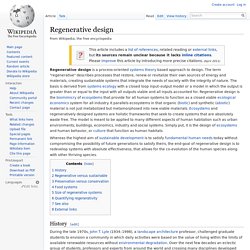
The term "regenerative" describes processes that restore, renew or revitalize their own sources of energy and materials, creating sustainable systems that integrate the needs of society with the integrity of nature. The basis is derived from systems ecology with a closed loop input–output model or a model in which the output is greater than or equal to the input with all outputs viable and all inputs accounted for. Regenerative design is the biomimicry of ecosystems that provide for all human systems to function as a closed viable ecological economics system for all industry. It parallels ecosystems in that organic (biotic) and synthetic (abiotic) material is not just metabolized but metamorphosed into new viable materials.
Ecosystems and regeneratively designed systems are holistic frameworks that seek to create systems that are absolutely waste free. History[edit] During the late 1970s, John T. Post-scarcity economy. This would require a sophisticated system of resource recycling, in conjunction with advanced productive technology that enables conditions of material abundance, such as automated systems capable of converting raw materials into finished goods[not verified in body], which in turn enable the free distribution[2] of most or all economic output and the common ownership of the means of production used therefor.
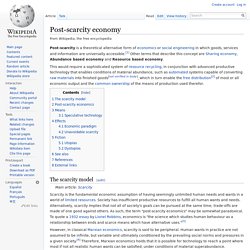
The scarcity model[edit] Scarcity is the fundamental economic assumption of having seemingly unlimited human needs and wants in a world of limited resources. Society has insufficient productive resources to fulfill all human wants and needs. Alternatively, scarcity implies that not all of society's goals can be pursued at the same time; trade-offs are made of one good against others. As such, the term "post-scarcity economics" may be somewhat paradoxical. However, in classical Marxian economics, scarcity is said to be peripheral.
Post-scarcity economics[edit] Resource recovery. Resource recovery is the selective extraction of disposed materials for a specific next use, such as recycling, composting or energy generation. The aim of the resource recovery is to extract the maximum practical benefits from products, delay the consumption of virgin natural resources, and to generate the minimum amount of waste. Resource recovery differs from the management of waste by using life cycle analysis (LCA) to offer alternatives to landfill disposal of discarded materials. A number of studies on Municipal Solid Waste (MSW) have indicated that administration, source separation and collection followed by reuse and recycling of the non-organic fraction and energy and compost/fertilizer production of the organic waste fraction via anaerobic digestion to be the favoured alternatives to landfill disposal. Recycling[edit] Recycling is a resource recovery practice that refers to the collection and reuse of disposed materials such as empty beverage containers.
Recovery methods[edit] Cradle-to-cradle design. Cradle to Cradle design (also referred to as Cradle to Cradle, C2C, cradle 2 cradle, or regenerative design) is a biomimetic approach to the design of products and systems.
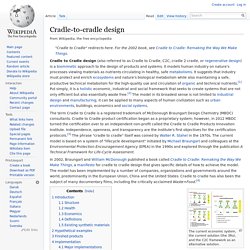
It models human industry on nature's processes viewing materials as nutrients circulating in healthy, safe metabolisms. It suggests that industry must protect and enrich ecosystems and nature's biological metabolism while also maintaining a safe, productive technical metabolism for the high-quality use and circulation of organic and technical nutrients.[1] Put simply, it is a holistic economic, industrial and social framework that seeks to create systems that are not only efficient but also essentially waste free.[2] The model in its broadest sense is not limited to industrial design and manufacturing; it can be applied to many aspects of human civilization such as urban environments, buildings, economics and social systems. Circular economy. The circular economy is a generic term for an industrial economy that is, by design or intention, restorative and in which material flows are of two types, biological nutrients, designed to reenter the biosphere safely, and technical nutrients, which are designed to circulate at high quality without entering the biosphere.
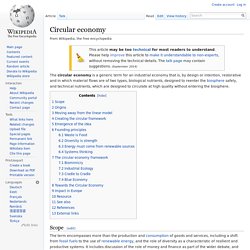
Scope[edit] Origins[edit] The circular economy is grounded in the study of feedback rich (non-linear) systems, particularly living systems.[2] A major outcome of this is the notion of optimising systems rather than components, or the notion of ‘design for fit’. As a generic notion it draws from a number of more specific approaches including cradle to cradle, biomimicry, industrial ecology, and the ‘blue economy’. Most frequently described as a framework for thinking, its supporters claim it is a coherent model that has value as part of a response to the end of the era of cheap oil and materials. Supply chain sustainability. Supply chain sustainability is a business issue affecting an organization’s supply chain or logistics network in terms of environmental, risk, and waste costs.
Sustainability in the supply chain is increasingly seen among high-level executives as essential to delivering long-term profitability and has replaced monetary cost, value, and speed as the dominant topic of discussion among purchasing and supply professionals. [citation needed] Background[edit] Many companies are limited to measuring the sustainability of their own business operations and are unable to extend this evaluation to their suppliers and customers. This makes determining their true environmental costs highly challenging and reduces their ability to remove waste from the supply chains. Sustainable design. Sustainable design (also called environmental design, environmentally sustainable design, environmentally conscious design, etc.) is the philosophy of designing physical objects, the built environment, and services to comply with the principles of social, economic, and ecological sustainability.[1] Theory[edit] The intention of sustainable design is to "eliminate negative environmental impact completely through skillful, sensitive design".[1] Manifestations of sustainable design require no non-renewable resources, impact the environment minimally, and connect people with the natural environment.
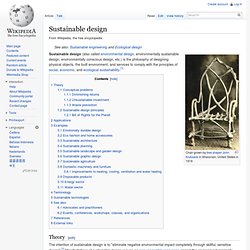
Beyond the "elimination of negative environmental impact", sustainable design must create projects that are meaningful innovations that can shift behaviour.